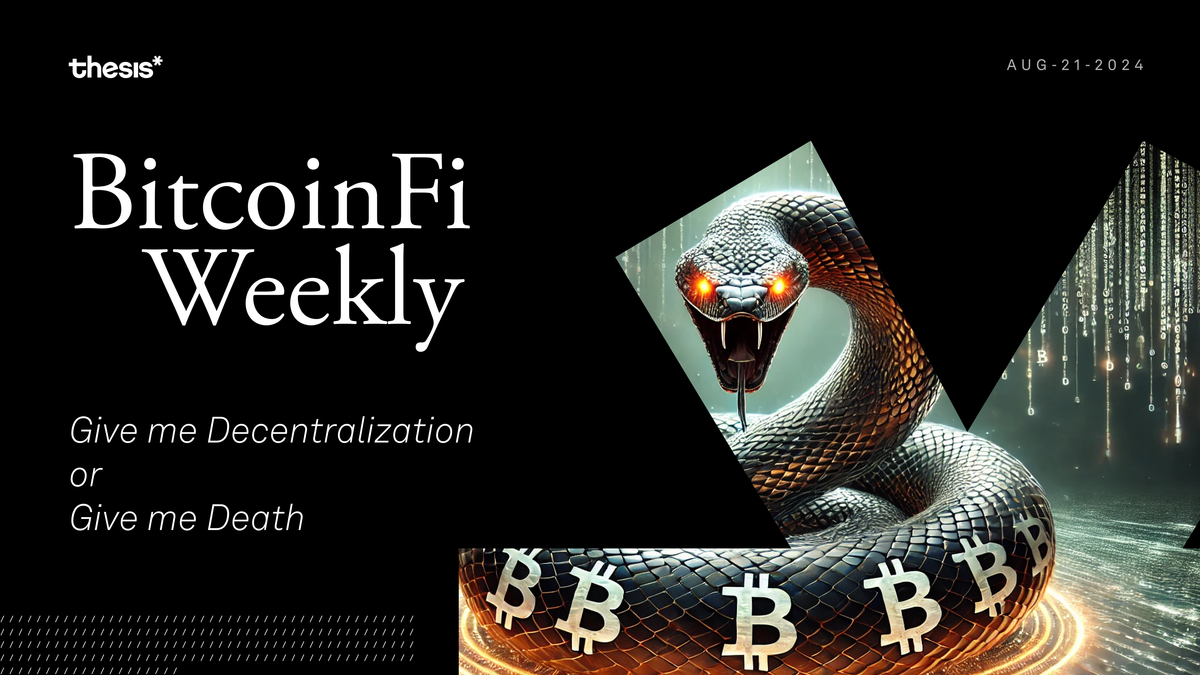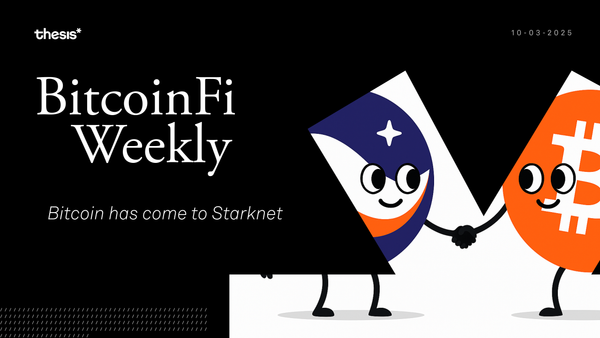Give me Decentralization or Give me Death
We've seen what happens when we forget our roots - the FTXs, the Celsius', the wBTCs of the world. These weren’t cautionary tales; they were alarm bells. Yet, in the midst of this chaos, tBTC continues its rise, proving that the decentralized spirit is alive and well.

Welcome to BitcoinFi Weekly. We cover where people use their BTC and what is changing in the Bitcoin world.
History rhymes, and in BitcoinFi, the tune is getting familiar. This week, we're taking a hard look at centralization's pitfalls and decentralization's promises. From tBTC's surge to new players in the BitcoinFi space, the landscape is shifting. But as we build, are we staying true to our roots? Let's dive into the lessons of the past and the innovations of the present.
Here’s this week’s rundown:
🏛️ Staying True to Decentralization
🚀 tBTC's Surging Liquidity
👀 DLC.Link: Safehaven or Subterfuge?
🌽 Corn: The Super Yield Network
Feature Piece: If We are not Decentralized, We are Nothing
There is a tendency among folks to forget the lessons of the past, to ignore the warnings etched in the collapse of empires and the fall of mighty institutions. This pattern, as old as time itself, finds its modern reflection in crypto—one of centralization gone awry, of power concentrated until it collapses under its own weight. We’ve seen it happen, and yet, here we are, watching it unfold again and again. The promises of permissionlessness and decentralization have seemingly been swallowed by the very thing we sought to escape.
Remember FTX? Yesterday's news, today's cautionary tale. Celsius, BlockFi, and most recently wBTC—same story, different names. You see the pattern here? When power’s in the hands of the few, disaster is inevitable. For all the rush to find product-market-fit, we’ve lost the plot. We find ourselves living in an age of grand delusions, where men believe themselves free while wearing chains of their own making. The centralized structures that we sought to replace have a way of creeping back in, cloaked in the guise of convenience and wrapped in the promise of profit.
To understand why decentralization is the antidote to risk, we must first understand how centralization breeds it.
At a very high level, there are three primary methods through which systemic risk can spread:
- Informational Contagion: Occurs when the expectation of a crisis leads to a self-fulfilling prophecy. Because fear spreads faster than truth, depositors will stampede to withdraw their funds, causing a bank run.
- Direct Contagion: This is transmitted through the web of financial relationships, such as the debt and credit links between banks. This type acts like fuses in a powder keg. One blowout and it cascades through the system, pulling everything down with it.
- Common Exposure: Refers to the risk that arises when many institutions hold the same or correlated assets so that a drop in the value of these assets can simultaneously threaten them all. Think dominoes.
In a network, the ability to withstand contagion depends on how “well-connected” the nodes are and how evenly the potential losses can be distributed among them. In a centralized system, a few large institutions are disproportionately connected to many smaller ones. As a result, everything is connected in tight, closed loops, and shocks are amplified, ricocheting through the network until they break everything in their path.
This is precisely what happened in the 2008 financial crisis, where the web of mortgage-backed securities and credit default swaps created a network of contagions that nearly brought down the global financial system.
Another prime example is the collapse of the Terra-Luna ecosystem in May 2022. The crisis was triggered by a combination of design flaws in the algorithmic stablecoin TerraUSD (UST), overleveraged positions, and a heavy reliance on the influence of a single individual. The informational contagion, fueled by Do Kwon's social influence, quickly morphed into a direct contagion as the sell-off in UST and LUNA tokens triggered a cascading effect across the interconnected DeFi ecosystem. The Terra-Luna debacle highlights the dangers of deification and social centralization.
In a decentralized system, power isn’t concentrated in the hands of the few; by definition, it’s spread across many. Each node in the network stands on its own, absorbing shocks independently and reducing the likelihood of a total collapse. Imagine a network where shocks to the system are like ripples in a pond. In a decentralized network, these ripples don’t turn into tsunamis. A larger number of nodes absorbs the losses, and the impact on each node is minimized.
Our industry’s story started as one of reclaiming power from the hands of the few and distributing it among the many. This is why we build. This is why Bitcoin was born, why Ethereum followed, why the world of crypto has grown from a spark to a fire. The big picture is not about creating new tools or making money. We build because we know the alternative. We build because we have seen the chains and we refuse to wear them.
But we build smarter. We ask ourselves tough questions. How can we stay true to the principles of decentralization when centralization seems so much easier, so much more profitable in the short term? It won't be easy. But then again, nothing worth doing ever is.
BitcoinFi Updates
tBTC Liquidity Surges to All-Time Highs as Arbitrum Activity Skyrockets
The foundation of BitcoinFi solidifies itself further as tBTC has reached all-time highs in both supply and the number of holders. This surge coincides with increased activity on Arbitrum, driven by GMX's recent integration of tBTC. The decision to include a tBTC-only market for trading BTC on GMX follows a thorough risk assessment by Chaos Labs. As more DeFi platforms adopt tBTC, we're witnessing the wBTC tide turn 👀.
DLC.Link: Safehaven or Subterfuge?
DLC.Link has just launched a new trust-minimized approach to wrapping Bitcoin using Discreet Log Contracts (DLCs), allowing institutions to mint dlcBTC on Arbitrum. This system employs a Taproot-based Bitcoin multisig and a network of attestors, while DLCs allow Bitcoin to be represented on other chains without sacrificing the original owner’s control.
However, while DLCs promise non-custodial escrow functionality and minimize online attack vulnerabilities, they also introduce significant complexities and potential weaknesses. Critics argue that the reliance on oracles and the limited decentralization at launch could compromise the system's integrity, while others point to the erosion of privacy when applied in broader protocols like DLC.Link. Despite these concerns, DLC.Link represents a significant step toward a more secure and decentralized wrapped Bitcoin, though its true impact on BitcoinFi remains to be seen.
Corn: The Super Yield Network
Corn is a new Ethereum Layer 2 network that aims to enhance Bitcoin's utility. Corn introduces BTCN, a “hybrid tokenized” Bitcoin that serves as the network's gas token. BTCN is backed 1:1 by native Bitcoin held through a combination of trusted custodians, smart contracts, and bridging protocols.
The network boasts its "Super Yield Network" mechanism, redirecting network-level yield back to users and protocols. This yield comes from BTCN gas fees and $CORN token emissions. $CORN token holders can stake their tokens to influence the distribution of this yield, effectively creating a chain-wide incentive structure similar to the "ve" tokenomics popularized by protocols like Curve Finance. But let’s not forget that these systems, no matter how cleverly designed, still rest on the shoulders of their participants. And human nature being what it is, you’ve always got to ask: what happens when the incentives start to shift? When the yield dries up, when the market turns? Does the whole thing hold together, or does it begin to unravel?
Closing Thoughts
In the end, it all comes down to why we're here. Bitcoin was born out of rebellion, but it's up to us to stoke and nurture the flame of rebellion. We've seen what happens when we forget our roots - the FTXs, the Celsius', the wBTCs of the world. These weren’t cautionary tales; they were alarm bells. Yet, in the midst of this chaos, tBTC continues its rise, proving that the decentralized spirit is alive and well. As we build this new world of BitcoinFi, we need to keep asking the hard questions. Are we really decentralizing, or just reshuffling the deck? Are we empowering the many, or just creating new elites?
If there's a topic you’d like us to cover or have questions, reach out at [email protected].
Learn more about Mezo at the following channels:
👾 Discord: https://discord.mezo.org
🕊 X: https://twitter.com/MezoNetwork
🖥 Website: https://mezo.org
🏦 Deposit Portal: https://mezo.org/hodl
ℹ️ Docs: https://info.mezo.org





